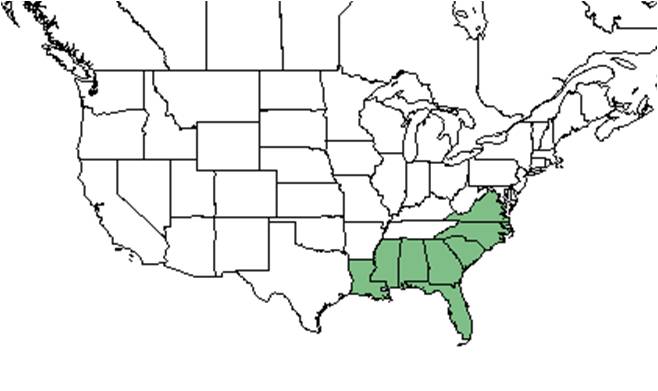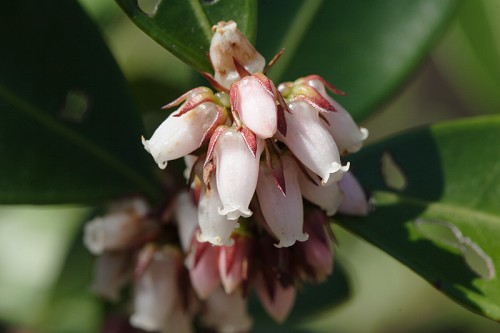Difference between revisions of "Lyonia lucida"
Juliec4335 (talk | contribs) (→Habitat) |
(→Distribution) |
||
| (19 intermediate revisions by 7 users not shown) | |||
| Line 18: | Line 18: | ||
}} | }} | ||
| − | Common names: | + | Common names: fetterbush lyonia; shining fetterbush<ref name=weakley>Weakley, A.S. 2020. Flora of the Southeastern United States. Edition of 20 October 2020. University of North Carolina at Chapel Hill, Chapel Hill, North Carolina.</ref> |
==Taxonomic notes== | ==Taxonomic notes== | ||
| − | Synonyms: ''Desmothamnus lucidus'' (Lamarck) Small; ''Neopieris nitida'' (Bartram ex Marshall) Britton | + | Synonyms: ''Desmothamnus lucidus'' (Lamarck) Small; ''Neopieris nitida'' (Bartram ex Marshall) Britton<ref name=weakley/> |
| + | |||
| + | Varieties: none<ref name=weakley/> | ||
==Description== | ==Description== | ||
<!-- Basic life history facts such as annual/perrenial, monoecious/dioecious, root morphology, seed type, etc. --> | <!-- Basic life history facts such as annual/perrenial, monoecious/dioecious, root morphology, seed type, etc. --> | ||
| − | A description of ''Lyonia lucida'' is provided in [http://efloras.org/florataxon.aspx?flora_id=1&taxon_id=250065690 The Flora of North America]. | + | A description of ''Lyonia lucida'' is provided in [http://efloras.org/florataxon.aspx?flora_id=1&taxon_id=250065690 The Flora of North America]. It is distinguishable by glossy, coriaceous leaves with a prominent vein along the margins.<ref name=weakley/> |
==Distribution== | ==Distribution== | ||
| + | ''L. lucida'' ranges from southeast Virginia to southern Florida, then west to east-central Louisiana. This species is also found in western Cuba.<ref name=weakley/> | ||
| + | |||
==Ecology== | ==Ecology== | ||
| + | |||
===Habitat=== | ===Habitat=== | ||
| − | ''L. lucida'' | + | ''L. lucida'' has been found in wet depressions of slash pine ridges, slash pine valleys, dunes, scrub oak areas, open pine woods, cypress swamps, pine flatwoods, thickets, streambanks, shrub bogs, titi swamps, and marshes.<ref name="FSU"> Florida State University Herbarium Database. URL: http://herbarium.bio.fsu.edu. Last accessed: June 2021. Collectors: Luis Almodovar, Loran C. Anderson, Tom Barnes, Andre F. Clewell, Suellen Folensbee, Robert K. Godfrey, Bruce Hansen, JoAnn Hansen, Robert L. Lazor, Sidney McDaniel, and L. B. Trott. States and counties: Florida: Franklin, Gadsden, Leon, Liberty, Martin, Okaloosa, Wakulla, and Walton.</ref> It is also found in disturbed areas including cut over pinelands, abandoned dumps, roadsides, and trails.<ref name="FSU"/> Associated species: ''Myrica cerifera, Ilex vomitoria, Leucothoe axillaris, Itea virginica, Ilex myrtifolia, I. coriacea, Cliftonia monophylla, Persea palustris, Lyonia lucida, Aronia arbutifolia, Cyrilla racemiflora, Smilax laurifolia'', and ''Quercus spp.''.<ref name="FSU"/> |
| − | + | ||
| + | ''L. lucida'' increased its presence in response to soil disturbance by heavy silviculture in North Carolina. It has shown regrowth in reestablished longleaf pinelands that were disturbed by this practice.<ref>Cohen, S., R. Braham, and F. Sanchez. (2004). Seed Bank Viability in Disturbed Longleaf Pine Sites. Restoration Ecology 12(4):503-515.</ref> It had mixed responses to soil disturbance by clearcutting and roller chopping in north Florida. The plant's foliar cover was dependent on time since disturbance in pinewood habitats with these disturbances.<ref>Lewis, C.E., G.W. Tanner, and W.S. Terry. (1988). Plant responses to pine management and deferred-rotation grazing in north Florida. Journal of Range Management 41(6):460-465.</ref> It also decreased cover and stems per acre in response to chopping in south Florida saw palmetto-pineland communities. It has shown resistance to regrowth in reestablished pinelands that were disturbed by chopping.<ref>Moore, W.H. (1974). Effects of Chopping Saw-Palmetto-Pineland Threeawn Range in South Florida. Journal of Range Management 27(2):101-104.</ref> | ||
| − | ''Lyonia lucida'' is frequent and abundant in the Central Florida Flatwoods/Prairies community | + | ''Lyonia lucida'' is frequent and abundant in the Central Florida Flatwoods/Prairies and North Florida Wet Flatlands community types as described in Carr et al. (2010).<ref>Carr, S.C., K.M. Robertson, and R.K. Peet. 2010. A vegetation classification of fire-dependent pinelands of Florida. Castanea 75:153-189.</ref> The habitats that it frequents include pocosins, wet woodlands, blackwater swamp forests, other acidic wetlands, especially if peaty.<ref name=weakley/> |
===Phenology=== <!--Timing off flowering, fruiting, seed dispersal, and environmental triggers. Cite PanFlora website if appropriate: http://www.gilnelson.com/PanFlora/ --> | ===Phenology=== <!--Timing off flowering, fruiting, seed dispersal, and environmental triggers. Cite PanFlora website if appropriate: http://www.gilnelson.com/PanFlora/ --> | ||
| − | ''L. lucida'' | + | ''L. lucida'' flowers from February to early June and fruits from September through October.<ref name=weakley/> |
<!--===Seed dispersal===--> | <!--===Seed dispersal===--> | ||
<!--===Seed bank and germination===--> | <!--===Seed bank and germination===--> | ||
| Line 41: | Line 47: | ||
===Pollination=== | ===Pollination=== | ||
| − | + | ''Lyonia lucida'' has been observed at the Archbold Biological Station to host bees such as ''Bombus impatiens'' (family Apidae) and sweat bees such as ''Lasioglossum placidensis'' (family Halictidae).<ref name="Deyrup 2015">Deyrup, M.A. and N.D. 2015. Database of observations of Hymenoptera visitations to flowers of plants on Archbold Biological Station, Florida, USA.</ref> | |
| − | + | Additionally, ''L. lucida'' has been observed to host true bugs such as ''Kleidocerys resedae'' (family Lygaeidae) and treehoppers such as ''Spissistilus festinus'' (family Membracidae).<ref>Discoverlife.org [https://www.discoverlife.org/20/q?search=Bidens+albaDiscoverlife.org|Discoverlife.org]</ref> | |
| − | + | <!--===Herbivory and toxicology===--> | |
| − | |||
| − | |||
| − | <!--=== | ||
<!--===Diseases and parasites===--> | <!--===Diseases and parasites===--> | ||
| − | ==Conservation and | + | ==Conservation, cultivation, and restoration== |
| − | == | + | ==Cultural use== |
==Photo Gallery== | ==Photo Gallery== | ||
<gallery widths=180px> | <gallery widths=180px> | ||
Latest revision as of 18:49, 15 June 2023
| Lyonia lucida | |
|---|---|

| |
| Photo by John R. Gwaltney, Southeastern Flora.com | |
| Scientific classification | |
| Kingdom: | Plantae |
| Division: | Magnoliophyta - Flowering plants |
| Class: | Magnoliopsida – Dicotyledons |
| Order: | Ericales |
| Family: | Ericaceae |
| Genus: | Lyonia |
| Species: | L. lucida |
| Binomial name | |
| Lyonia lucida (Lam.) K. Koch | |

| |
| Natural range of Lyonia lucida from USDA NRCS Plants Database. | |
Common names: fetterbush lyonia; shining fetterbush[1]
Contents
Taxonomic notes
Synonyms: Desmothamnus lucidus (Lamarck) Small; Neopieris nitida (Bartram ex Marshall) Britton[1]
Varieties: none[1]
Description
A description of Lyonia lucida is provided in The Flora of North America. It is distinguishable by glossy, coriaceous leaves with a prominent vein along the margins.[1]
Distribution
L. lucida ranges from southeast Virginia to southern Florida, then west to east-central Louisiana. This species is also found in western Cuba.[1]
Ecology
Habitat
L. lucida has been found in wet depressions of slash pine ridges, slash pine valleys, dunes, scrub oak areas, open pine woods, cypress swamps, pine flatwoods, thickets, streambanks, shrub bogs, titi swamps, and marshes.[2] It is also found in disturbed areas including cut over pinelands, abandoned dumps, roadsides, and trails.[2] Associated species: Myrica cerifera, Ilex vomitoria, Leucothoe axillaris, Itea virginica, Ilex myrtifolia, I. coriacea, Cliftonia monophylla, Persea palustris, Lyonia lucida, Aronia arbutifolia, Cyrilla racemiflora, Smilax laurifolia, and Quercus spp..[2]
L. lucida increased its presence in response to soil disturbance by heavy silviculture in North Carolina. It has shown regrowth in reestablished longleaf pinelands that were disturbed by this practice.[3] It had mixed responses to soil disturbance by clearcutting and roller chopping in north Florida. The plant's foliar cover was dependent on time since disturbance in pinewood habitats with these disturbances.[4] It also decreased cover and stems per acre in response to chopping in south Florida saw palmetto-pineland communities. It has shown resistance to regrowth in reestablished pinelands that were disturbed by chopping.[5]
Lyonia lucida is frequent and abundant in the Central Florida Flatwoods/Prairies and North Florida Wet Flatlands community types as described in Carr et al. (2010).[6] The habitats that it frequents include pocosins, wet woodlands, blackwater swamp forests, other acidic wetlands, especially if peaty.[1]
Phenology
L. lucida flowers from February to early June and fruits from September through October.[1]
Pollination
Lyonia lucida has been observed at the Archbold Biological Station to host bees such as Bombus impatiens (family Apidae) and sweat bees such as Lasioglossum placidensis (family Halictidae).[7] Additionally, L. lucida has been observed to host true bugs such as Kleidocerys resedae (family Lygaeidae) and treehoppers such as Spissistilus festinus (family Membracidae).[8]
Conservation, cultivation, and restoration
Cultural use
Photo Gallery
Lyonia lucida Photo by John R. Gwaltney, Southeastern Flora.com
Flowers of Lyonia lucida Photo by John R. Gwaltney, Southeastern Flora.com
References and notes
- ↑ 1.0 1.1 1.2 1.3 1.4 1.5 1.6 Weakley, A.S. 2020. Flora of the Southeastern United States. Edition of 20 October 2020. University of North Carolina at Chapel Hill, Chapel Hill, North Carolina.
- ↑ 2.0 2.1 2.2 Florida State University Herbarium Database. URL: http://herbarium.bio.fsu.edu. Last accessed: June 2021. Collectors: Luis Almodovar, Loran C. Anderson, Tom Barnes, Andre F. Clewell, Suellen Folensbee, Robert K. Godfrey, Bruce Hansen, JoAnn Hansen, Robert L. Lazor, Sidney McDaniel, and L. B. Trott. States and counties: Florida: Franklin, Gadsden, Leon, Liberty, Martin, Okaloosa, Wakulla, and Walton.
- ↑ Cohen, S., R. Braham, and F. Sanchez. (2004). Seed Bank Viability in Disturbed Longleaf Pine Sites. Restoration Ecology 12(4):503-515.
- ↑ Lewis, C.E., G.W. Tanner, and W.S. Terry. (1988). Plant responses to pine management and deferred-rotation grazing in north Florida. Journal of Range Management 41(6):460-465.
- ↑ Moore, W.H. (1974). Effects of Chopping Saw-Palmetto-Pineland Threeawn Range in South Florida. Journal of Range Management 27(2):101-104.
- ↑ Carr, S.C., K.M. Robertson, and R.K. Peet. 2010. A vegetation classification of fire-dependent pinelands of Florida. Castanea 75:153-189.
- ↑ Deyrup, M.A. and N.D. 2015. Database of observations of Hymenoptera visitations to flowers of plants on Archbold Biological Station, Florida, USA.
- ↑ Discoverlife.org [1]

